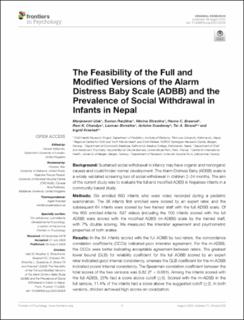| dc.contributor.author | Ulak, Manjeswori | |
| dc.contributor.author | Ranjitkar, Suman | |
| dc.contributor.author | Shrestha, Merina | |
| dc.contributor.author | Braarud, Hanne Cecilie | |
| dc.contributor.author | Chandyo, Ram K. | |
| dc.contributor.author | Shrestha, Laxman | |
| dc.contributor.author | Guedeney, Antoine | |
| dc.contributor.author | Strand, Tor A | |
| dc.contributor.author | Kvestad, Ingrid | |
| dc.date.accessioned | 2021-06-17T12:13:55Z | |
| dc.date.available | 2021-06-17T12:13:55Z | |
| dc.date.created | 2020-09-26T19:21:40Z | |
| dc.date.issued | 2020 | |
| dc.Published | Frontiers in Psychology. 2020, 11:2025 1-10. | |
| dc.identifier.issn | 1664-1078 | |
| dc.identifier.uri | https://hdl.handle.net/11250/2759984 | |
| dc.description.abstract | Background: Sustained social withdrawal in infancy may have organic and nonorganic causes and could hinder normal development. The Alarm Distress Baby (ADBB) scale is a widely validated screening tool of social withdrawal in children 2–24 months. The aim of the current study was to evaluate the full and modified ADBB in Nepalese infants in a community-based study.
Methods: We enrolled 600 infants who were video recorded during a pediatric examination. The 36 infants first enrolled were scored by an expert rater, and the subsequent 64 infants were scored by two trained staff with the full ADBB scale. Of the 600 enrolled infants, 597 videos (including the 100 infants scored with the full ADBB) were scored with the modified ADBB (m-ADBB) scale by the trained staff, with 7% double scoring. We measured the interrater agreement and psychometric properties of both scales.
Results: In the 64 infants scored with the full ADBB by two raters, the concordance correlation coefficients (CCCs) indicated poor interrater agreement. For the m-ADBB, the CCCs were better indicating acceptable agreement between raters. The greatest lower bound (GLB) for reliability coefficient for the full ADBB scored by an expert rater indicated good internal consistency, whereas the GLB coefficient for the m-ADBB indicated poorer internal consistency. The Spearman correlation coefficient between the total scores of the two versions was 0.82 (P < 0.001). Among the infants scored with the full ADBB, 25% had a score above cutoff (≥5). Scored with the m-ADBB in the full sample, 11.4% of the infants had a score above the suggested cutoff (≥2). In both versions, children achieved high scores on vocalization.
Conclusion: Our findings suggest that the m-ADBB is an acceptable approach to achieve adequate interrater agreement in a large community-based study in Nepal. Results indicate high prevalence of social withdrawal in this population. There are, however, uncertainties on the internal consistency of the scales in this setting, and the validity of the scales needs to be investigated further. More effective training strategies for administration and additional cultural-specific instructions could be important measures to explore before implementing the scale further in this setting. | en_US |
| dc.language.iso | eng | en_US |
| dc.publisher | Frontiers Media | en_US |
| dc.relation.uri | https://www.ncbi.nlm.nih.gov/pmc/articles/PMC7479187/pdf/fpsyg-11-02025.pdf | |
| dc.rights | Navngivelse 4.0 Internasjonal | * |
| dc.rights.uri | http://creativecommons.org/licenses/by/4.0/deed.no | * |
| dc.title | The Feasibility of the Full and Modified Versions of the Alarm Distress Baby Scale (ADBB) and the Prevalence of Social Withdrawal in Infants in Nepal | en_US |
| dc.type | Journal article | en_US |
| dc.type | Peer reviewed | en_US |
| dc.description.version | publishedVersion | en_US |
| dc.rights.holder | Copyright 2020 Ulak, Ranjitkar, Shrestha, Braarud, Chandyo, Shrestha, Guedeney, Strand and Kvestad | en_US |
| dc.source.articlenumber | 2025 | en_US |
| cristin.ispublished | true | |
| cristin.fulltext | original | |
| cristin.qualitycode | 2 | |
| dc.identifier.doi | 10.3389/fpsyg.2020.02025 | |
| dc.identifier.cristin | 1833792 | |
| dc.source.journal | Frontiers in Psychology | en_US |
| dc.source.40 | 11:2025 | |
| dc.identifier.citation | Frontiers in Psychology. 2020, 11, 2025. | en_US |
| dc.source.volume | 11 | en_US |

